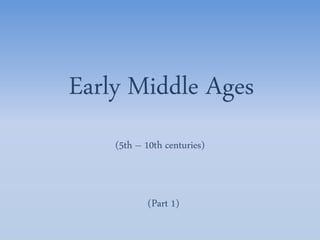
Early Middle Ages - Unit 1 - Part 1 - New
- 1. (5th – 10th centuries) Early Middle Ages (Part 1)
- 2. 1) Draw a Concept Map of the Unit
- 3. 2) Explain how was the Roman Empire in the 4th-5th cent. The Roman Empire was suffering a severe crisis. This crisis was economic, political and social. The Roman Empire couldn’t stop the attacks of the Huns and the Germanic tribes. 3) Explain what happened in 395 a.D. In 395 a.D. the emperor Theodosius divided the Roman Empire in two parts. • The Western Roman Empire (Rome) and • The Eastern Roman Empire (Constantinople). The intention was to improve the government and the protection of the Empire.
- 5. 4) Explain all you know about the Huns and the Germanic tribes. The Huns and the Germanic peoples were nomadic tribes that attacked fiercely the Roman Empire. • The Huns came from Asia; they were commanded by Attila. They attacked the Germanic tribes and the Roman Empire. • The Germanic peoples came from Scandinavia and settled in the frontiers of the Roman Empire. They also attacked the Roman Empire.
- 7. Batalla de los Campos Cataláunicos o de Chalons 451 (1). Atila inicia la batalla con los arqueros hunos lanzando una lluvia de flechas contra toda la línea de los aliados. Autor Steve Noon (Fuente: arrecaballo.es)
- 8. Cena en la corte de Atila rey de los hunos. A pesar de lo que la leyenda dice de él, Atila fue un político astuto que conocía el valor de la gentileza y la cortesía en la diplomacia, comía en cuencos de madera mientras sus invitados lo hacían en vajilla de oro y plata.(Fuente: arrecaballo.es)
- 9. 5) Explain the Fall of the Roman Empire. In 476 a.D. a Germanic tribe called the Heruli and their leader Odoacer defeated the last Roman emperor of the West Romulus Augustulus. Odoacer proclaimed himself king of Italy.
- 11. 6) What happened to the Eastern Roman Empire? The Eastern Roman Empire survived the fall of Rome and the attacks of the Germanic tribes. We study it as the Byzantine Empire and it lasted until 1453 when Constantinople was conquered by the Ottoman Turks. The Byzantine Empire
- 14. 7) Tell me some characteristics of the Byzantine Empire It was very prosperous and advanced. They considered themselves the heirs (herederos) of the Roman Empire • Economy was based on industry and trade. • Cities were important (urban society) • The Byzantine art was very luxurious and elaborated. Extra information: • In architecture they constructed great buildings such as Hagia Sophia.
- 15. Map of the Byzantine Empire (Before Justinian and after Justinian) Source: Wikipedia
- 16. 8) Where was the Byzantine Empire located? The Byzantine Empire was located in eastern Mediterranean. It included: • Eastern Europe, • Middle East and • Northeastern Africa. 9) What territories did Justinian I conquer? The territories that Justinian I conquered were: • The Vandal kingdom of North Africa. • Italian Peninsula • Southeastern Iberian Peninsula
- 17. 10) Tell me some examples of the Byzantine art. Some examples of Byzantine art were: • In architecture the Hagia Sophia Church and the Basilica of San Vitale in Ravenna. • The Mosaics (for example the mosaics of San Vitale in Ravenna). • The Icons, that are religious images of Jesus Christ, the Virgin and the Saints. For more information: • Take a look to the presentation of Byzantine Art. • Video Academia Play (3 min) of Hagia Sophia. Link • Video Ted Ed (6 min) of Hagia Sophia. Link
- 19. 11) Explain the East-West Schism. (What it is, when it happened, why it happened, what two Christian religions we will have from now on). The East-West Schism (cisma, división) was the separation between the Roman Church and the Eastern Church. It took place in 1054 because of the rivalry between the patriarch of Constantinople and the Pope of Rome. As a consequence, we will have the Orthodox Church and the Catholic Church. For more information: • El cisma de Oriente. (Vídeo, 3 min.). Enlace • Great Schism – Khan Academy (Video, 9 min). Link
- 21. 12) Who were the Germanic tribes? The Germanic tribes were groups of people that came from Northern Europe. They were nomadic and their main economic activities were agriculture, livestock farming and military activities. Germanic Kingdoms Extra Information: • They shared a common language and traditions and each tribe followed a leader that was chosen among the best candidates (“Primus inter paris”). • They attacked the Roman Empire, but they also worked for the Romans as mercenaries and received territories in exchange.
- 23. Germanic Family
- 24. Guerreros burgundios siglo IV. Eran aliados de Roma y se asentaron en la cuenca del Rin, posteriormente ocuparían Borgoña. Autor Angus McBride
- 25. 13) What were the consequences of the attacks of the Germanic tribes? (political, economic and urban) Because of these attacks the Western Roman Empire collapsed (disappeared). It was divided into smaller territories called Germanic Kingdoms. In economy industry and trade disappeared and agriculture and livestock farming became the most important economic activities. Cities were abandoned and culture and art disappeared. Extra Information: • the Germanic people became the rulers of the new kingdoms because they conquered the different territories and imposed themselves in the military aspect.
- 26. 14) Tell me some Germanic tribes and the territories where they established themselves. • Suevi: they established in the Iberian Peninsula • Visigoths: in Hispania (or the Iberian Peninsula) • Franks: in France • Burgundians: in eastern France • Vandals. in north Africa • Ostrogoths: in Italy • Lombards: in Italy later • Anglo-Saxons: in England